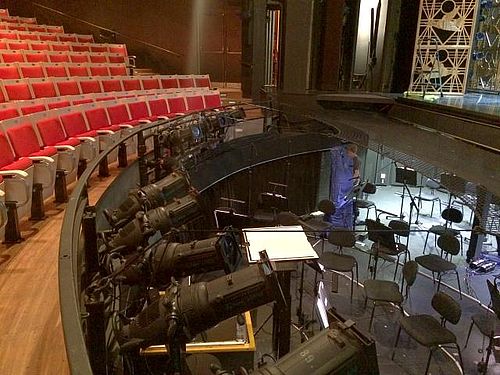Title of paper under discussion
Is Playing in the Pit Really the Pits?: Pain, Strength, Music Performance Anxiety, and Workplace Satisfaction in Professional Musicians in Stage, Pit, and Combined Stage/Pit Orchestras
Authors
Dianna T. Kenny, Timothy R. Driscoll, Bronwen J. Ackermann
Journal
Medical Problems of Performing Artists 31(1):1-7, March 2016
Link to paper (free access)
Overview
This Australian study set out to ascertain whether orchestral environment – being on stage, in a pit, or a combination of the two – was a risk factor affecting musician wellbeing. Players from eight different orchestras (three stage-only symphonic orchestras, three mixed stage/pit orchestras and two dedicated pit orchestras) underwent physical and mental assessments. Pit musicians demonstrated greater shoulder and elbow strength while mixed stage/pit musicians had greater physical flexibility. Regarding physical exertion, pit musicians reported the highest levels of all, both rehearsing and performing; however, mixed stage/pit musicians reckoned they used less physical exertion in the pit than on stage. Severity of music performance anxiety was highest amongst pit musicians, as was low job satisfaction and frequency of feeling bullied. “Determining the impact that these different working environments may have on performer health”, the authors argue, “potentially enables targeted workplace modifications to be made.”

Introduction
In light of the wide range of ‘intrinsic risk factors’ (e.g. performance anxiety, technical demands, conflict with colleagues) and ‘extrinsic risk factors’ (e.g. orchestra configuration, noise, temperature, lighting, repertoire, schedule) to which they are exposed, it is perhaps no wonder that previous studies have revealed 70 to 80% of orchestral musicians reporting occupational injury at some point in their careers.
Might, our authors wondered, different work environments be associated with different sets of physical and mental health issues? Working in a pit, for example, is commonly deemed to be especially associated with various ‘extrinsic risk factors’, including high noise levels, low lighting levels and cramped playing conditions. A musician from an orchestra with a mixed stage/pit schedule observed: “when we have the pit seasons, operas and ballets and other programs close to one another, we clearly have more injuries during these schedules.”
Having established the importance of this field of study, Kenny and her colleagues suggest that “[the] scant available research on this topic warrants further attention to guide efforts to reduce injury risk. Determining the impact that these different working environment [stage, pit and mixed stage/pit] may have on performer health potentially enables targeted workplace modifications to be made.”

Method
Musicians from 8 major Australian orchestras took part in the study, falling into three groups according to the type of work their orchestra performed: stage-only musicians (Sydney Symphony, Melbourne Symphony, Tasmanian Symphony), combined stage/pit musicians (Adelaide Symphony, Queensland Symphony, Western Australia Symphony) and pit-only musicians (Australian Opera and Ballet, Opera Victoria).
Each musician was invited to participate in a self-report survey (380 completed) and a physical examination (407 completed):
Self-report survey
1) A self-rating of the frequency and severity of any musculoskeletal pain that interferes with playing
2) A questionnaire relating to Music performance anxiety
3) A questionnaire relating to “Trait anxiety” (anxiety as a ‘personality trait’)
4) A questionnaire relating to Social phobia
5) A questionnaire relating to Depression
6) A questionnaire relating to Anxiety and Depression
7) A questionnaire relating to Core Self-evaluation (self esteem, neuroticism etc)
8) A questionnaire relating to Alcohol Use
9) A questionnaire to determine a) the Level of Bullying experienced in the workplace and b) the Effect of such bullying on wellbeing
10) A questionnaire to determine Satisfaction with Work
11) A questionnaire to determine Workload (time spent rehearsing/performing)
12) A questionnaire regarding levels of Physical Exertion in a) performance b) rehearsal c) private practice
Physical assessment
The strengths of various joint actions (e.g. elbow extension, wrist flexion etc) were measured by a team of health professionals.

Results
Of all the musicians taking part 21% were pit-only, 43% stage/pit and 36% stage-only. There were no significant differences between groups in terms of gender balance, average age, instrument type or professional experience.
Stage-only and stage/pit musicians reported using greater physical exertion during their private practice compared with pit-only musicians. When describing touring, stage-only musicians again reported using more physical exertion compared with pit-only musicians. When stage/pit musicians were asked which required more physical exertion, stage or pit performances, they answered stage; however, pit-only musicians reported the highest levels of physical exertion, in performances and rehearsals, of all the groups.
In terms of reporting pain/injury all three groups showed similar results. Asked to consider past or present pains/injuries in their professional careers, 81-95% reported that their playing had caused pain or injury, 85-90% reported that pain or injury had affected their playing, 18-23% reported that medical conditions had affected their playing, 6-10% reported that previous surgery had affected their playing and 46-56% reported that they were currently playing with a pain or injury.
Physical characteristics differed between the three groups. Stage-only musicians were found to have significantly less strength in terms of left and right shoulder internal rotation, and left and right elbow flexion and extension. (These findings were not down to instrument type, sex or age). Stage-only musicians demonstrated, however, a significantly greater flexibility (range of movement) in pronation.
The overall playing workload in terms of private practice, total calls and overall playing time was similar between all three groups.
Reported levels of music performance anxiety were higher amongst pit-only, compared with stage/pit, musicians; and pit-only players were significantly more likely to use beta-blockers to manage their performance compared with stage-only players (26% vs 12.5%). None of the other reported psychosocial factors – social phobia, trait anxiety, depression, core self-evaluation, alcohol use) – came up as significantly different between groups.
Regarding bullying the authors recorded that “across the three orchestra types, 25% of musicians reported a bullying experience in the 6 months prior to completing the questionnaire” but that there was marked variation between groups: for pit-only musicians the figure was 36.8%, and for stage-only it was under half that at 16.7%. Orchestral management was the most commonly identified source of the bullying.
Though all three groups reported similar overall levels of satisfaction with work, significant differences emerged when it came to specific areas. Stage-only players were more satisfied (compared with the other two groups) with their workplace, pay, promotion prospects, employers and liaison orchestral mangers. Regarding attitudes towards professional colleagues, stage-only and stage/pit musicians were significantly happier with their section leaders, and their fellow musicians in general, compared with pit-only musicians.

Discussion
Kenny and her colleagues refer us to other research identifying two contrasting sources of stress for orchestral musicians: overload and boredom. They suggest that pit-only musicians may experience a range of “dissatisfactions” that contribute to such stress; in their words: “Pit orchestra musicians reported less satisfaction with many aspects of their work, including their managers and section leaders, their rates of pay, and their career prospects. They were also less satisfied with their workplaces, no doubt because they are often seated in crowded, dark, and noisy work environments. In addition they reported greater performance anxiety, more concern about bullying, lack of artistic integrity, task difficulty, and social tension within the ensemble.”
Such findings and further research, the authors hope, “might offer important insights to work, health, and safety mangers whose task it is to provide a safe workplace and to reduce costs related to absenteeism and workers’ compensation.”
Coda
Piano Concerto No. 2, Op 69 – Ferdinand Hiller
3rd movement: Allegro con fuoco
Tasmanian Symphony Orchestra
Conductor/piano – Howard Shelley